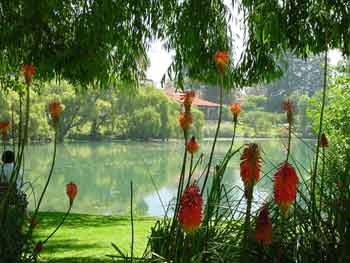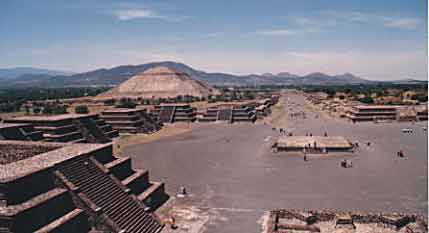Announcement:
2nd Latin American School of High Energy Physics
San Miguel Regla, Mexico 1 - 14 June, 2003 Organized jointly by CERN, CLAF, CONACyT and DPF MPs
Other sponsors: EU, Brazil, Spain, Portugal, Italy and France

The 2003 Latin-American School of High-Energy Physics will be organized jointly by the European Organization for Nuclear Research (CERN), Geneva, Switzerland and the Centro Latino Americano de Fisica (CLAF), together with Division of Particles and Fields of the Mexican Physical Society. The basic aim of the School is to teach various aspects of high-energy physics, and especially theoretical physics, primarily to Post-Graduates in experimental particle physics, typically aged under thirty years and about one year from submitting their Ph.D. theses. However, a few Latin American Post-Doctoral students in experimental high-energy physics and Master's Degree students in theoretical physics may be accepted, assuming their background knowledge in theoretical physics is of approximately the same level as the experimental Ph.D. students.
The Schools of Physics are designed to give a survey of up-to-date information, rather than to be a training course. An outline of each of the lecture courses and reading lists will be sent to the selected students together with their letters of acceptance.
ACCOMMODATION
SCIENTIFIC PROGRAMME
DISCUSSION SESSIONS
POSTER SESSION
TRAVEL
PARTICIPATION
APPLICATION
LOCAL ORGANIZING COMMITTEE
INTERNATIONAL SCIENTIFIC COMMITTEE
ENQUIRIES& CORRESPONDENCE
OTHER LINKS
DATE & PLACE OF THE SCHOOL:
The second Latin-American School of High-Energy Physics will be held in The Hacienda San Miguel Regla, Mexico, from Sunday 1 to Saturday 14 June 2003. The Hacienda San Miguel Regla located about 90 kms north of Mexico City was built in the XVII century and belonged to "Pedro Romero de Terreros", "Conde de Regla". Today is an exclusive and modern hotel, surrounded of a forest atmosphere in the valley of the "Huasca".
ACCOMMODATION:
All those participating in the School will be lodged in the Hacienda San Miguel Regla in which all rooms, which will be shared, have chimney, room service, purified water, TV and parabolic. The leisure activities available include use of swimming pool, gardens, lakes where to fish or to row, games saloon equipped with billiard tables, ping-pong and "futbolitos", tennis court, etc. Some excursions will be organized and one or two afternoons will be free.
SCIENTIFIC PROGRAMME (draft):
The scientific programme is as follows:
- Standard Model and Field theory, Ronald KLEISS (Nijmegen University, Netherlands)
- QCD, Benjamin GRINSTEIN (University of California in San Diego, USA)
- Beyond the Standard Model, Chris QUIQQ (Fermilab, USA)
- Heavy Ions at the LC, Jurgen SCHUKRAFT (CERN, Switzerland)
- Neutrinos, Pilar HERNANDEZ (Univ. Complutense de Madrid, Spain)
- Flavour Physics, Belen GAVELA (Univ. Autonoma de Madrid, Spain)
- Astrophysics, Carlos FRENK (University of Durham, United Kingdom)
- Instrumentation, Jurgen ENGELFRIED (Univ. Autonoma de San Luis Potosi, Mexico)
- Trigger/DAQ, Nick ELLIS (CERN, Switzerland )
- Heavy Ions Physics, Ulrich HEINZ (Ohio S. Univ., USA)
- The Auger project, Gustavo MEDINA TANCO (Univ. Sao Paulo, Brazil)
There will be around thirty lectures in all, each lasting about one hour, followed by a fifteen-minute period for questions and discussion. Students will be expected to present their current research work in the form of a special Poster Session which is planned to take place on Tuesday 10 June.
DISCUSSION SESSIONS :
Discussion sessions, which are intended to clarify points which may be obscure from the lectures, will be held most afternoons and will last about 75 minutes.
The discussion sessions will be led by:
- Gabriel LOPEZ (CINVESTAV, Mexico)
- Alejandro AYALA (UNAM, Mexico)
- Helio Nogima (Brazil)
- Diego HARARI (UBA, Argentina)
- Marta LOSADA (UA Nari–o, Colombia)
- Ramon Mendez-Galain (URM, Uruguay)
POSTER SESSION:
Students are expected to produce and display, as posters, a short description of the experiment on which they are working and some recent results. They should bring with them graphs, pictures and other suitable material for display on pin boards. The evening of Tuesday 10 June will be devoted to their presentation during an informal session when refreshments will be provided.
LANGUAGE:
The working language of the School will be English. Participants should therefore have a good understanding of English to enable them to benefit from the School.
PROCEEDINGS:
The School Proceedings will be published as a CERN Yellow Report in Spring 2004. Each participant will receive one copy free of charge.
TRAVEL:
Students should arrange to arrive at Hacienda San Miguel Regla for registration during the afternoon or evening of Sunday, 1 June. The School will end on the morning of Saturday, 14 June after breakfast. The nearest international airport is in Mexico City (about 100 kms).
Participants will be met by specially organized buses - exact times and places will be given in the second Bulletin.
PARTICIPATION:
The School is open to postgraduates in experimental particle physics, typically aged under thirty years and about one year from submitting their PhD theses. However, a few Latin American Post-Doctoral students in experimental high-energy physics and Master's Degree students in theoretical physics may be accepted, assuming their background knowledge in theoretical physics is of approximately the same level as the experimental PhD students. The number of students will be about 80, mostly from Latin America, although the School is also open to those from other countries. Personal contacts and informal discussions among the participants during leisure time are an important aspect of the School and, for this reason, participants are asked to note that they should not be accompanied by family members or friends.
Students from Latin American countries will have their School Fees and travel costs (at the cheapest possible rate) paid by the School. This has been made possible through the generosity of various bodies wishing to support this new initiative.
The School Fee will be approximately $1000 (US) per student, and will cover tuition, full board and lodging at the Hotel from dinner on Sunday 1 June to breakfast on Saturday 14 June 2003, with coffee, tea or cold drinks during the morning and afternoon breaks, as well as some social activities and excursions. The Fee does not include travel expenses from participants' home institutes to San Miguel Regla and back. We expect to be able to cover travel expenses and the school fee for a large fraction of the Latin American students.
APPLICATION:
Applications to attend the School should include:
- a completed application form
- a 100-word summary of current work
- a letter of reference from the candidate's professor or supervisor.
The Application Form for the 2003 Latin-American School of High-Energy Physics should be completed and sent at the latest on 10 January, 2003.
The submission of the completed application form must be accompanied by a letter of reference from the student's professor or supervisor (hard copy on headed paper, signed and dated): without this, applications will not be considered. The supervisor/professor's name and the date of the letter should be indicated in the appropriate boxes on the WWW form. The letter itself should be sent to Danielle Metral, School Administrator (see Enquiries and Correspondence below).
Students who wish to apply but who do not have a suitable browser for the WWW application form should request a hard copy of the form from the School Administrator (see Enquiries and Correspondence), stating clearly their name and postal address. Their 100-word summary of current work should be sent by electronic mail to the School Administrator.
Candidates should ensure that their application, letter of reference and 100-word summary reach the School Administrator by 11 January, 2003.
The selection of the students will be made by the International Scientific Committee, and all applicants will be informed by the end of February 2003 whether their application has been successful.
LOCAL ORGANIZING COMMITTEE:
- Alberto SANCHEZ-HERNANDEZ (CINVESTAV) Chair/Local Director
- Guillermo CONTRERAS (CINVESTAV-Merida) Co-Chair
- Heriberto CASTILLA (CINVESTAV)
- Arturo FERNANDEZ (BUAP)
- Jurgen ENGELFRIED (UASLP)
- Arturo MENCHACA (UNAM)
- Myriam MONDRAGON (UNAM)
- Luis M. MONTANO (CINVESTAV)
- Lukas NELLEN (UNAM)
- Miguel A. PEREZ (CINVESTAV)
- Julian FELIX (UAGto.)
- Luis M. VILLASENOR (UMSNH)
INTERNATIONAL SCIENTIFIC COMMITTEE:
- Alvaro DE RUJULA (CERN, Switzerland)
- John ELLIS (CERN, Switzerland)
- Nick ELLIS (CERN, Switzerland)
- Carlos GARCIA CANAL (UNLP, Argentina)
- Marcelo GUZZO (Unicamp, Brazil)
- Egil LILLESTOL (CERN & Univ. of Bergen, Switzerland) Schools Director
- John MARCH-RUSSEL (CERN, Switzerland)
- Luis MASPERI (CLAF)
- Alberto SANCHEZ-HERNANDEZ (CINVESTAV, Mexico) Local Director
- Rudiger VOSS (CERN, Switzerland)
- Arnulfo ZEPEDA (CINVESTAV, Mexico)
SUPPORTING BODIES:
The School is organized in co-operation with UNESCO and CONACyT-Mexico, and through the generous support of various bodies and Ministries, including from Spain, Italy, France and Portugal
ENQUIRIES & CORRESPONDENCE:
All enquiries and correspondence related to the Latin-American School of Physics should be addressed to:
Mme Danielle Metral
Organizing Secretary Schools of Physics CERN
CH-1211 GENEVA 23 Switzerland
E-mail:

